

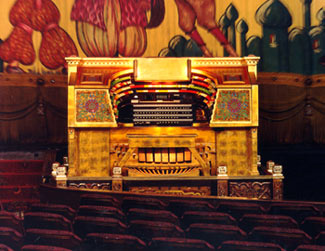
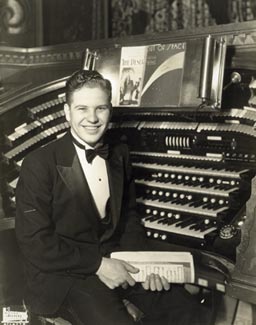 Mighty
Mo was custom-made for the Fox Theatre in 1929 for the then
astronomical
price of $42,000.00 by M. P. Möller Inc. of Hagerstown, Maryland.
It's the second largest theater organ in the world with 42 ranks,
four manuals and 376 stop tabs, having been surpassed in size
- but not melodic beauty - around 1932 by the 58-rank Wurllitzer
at Radio City Music hall. There are 3,622 pipes, spread out over
five chambers, ranging in size from a ball point pen to 32 feet
tall and big enough around for a man to stand in. The wind required
for the organ is supplied by a blower which is powered by a
75-horsepower
motor. This electro-pneumatically operated instrument is so vast
and complex that it has real instruments in it such as a marimba,
xylophone and glockenspiel.
Mighty
Mo was custom-made for the Fox Theatre in 1929 for the then
astronomical
price of $42,000.00 by M. P. Möller Inc. of Hagerstown, Maryland.
It's the second largest theater organ in the world with 42 ranks,
four manuals and 376 stop tabs, having been surpassed in size
- but not melodic beauty - around 1932 by the 58-rank Wurllitzer
at Radio City Music hall. There are 3,622 pipes, spread out over
five chambers, ranging in size from a ball point pen to 32 feet
tall and big enough around for a man to stand in. The wind required
for the organ is supplied by a blower which is powered by a
75-horsepower
motor. This electro-pneumatically operated instrument is so vast
and complex that it has real instruments in it such as a marimba,
xylophone and glockenspiel.
The great organ is indisputably one of the crowning glories of the M. P. Möller Organ Company. Listed as Opus 5566, it was one of the last theatre organs the Hagerstown firm constructed, after a long career of theatre-organ building that started around 1913. The organ was built for the theater mainly to provide accompaniment to silent movies, but when the theater opened, the age of silent films had past and talkies were the in thing. While the organ was used for concerts and sing-alongs, it wasn't until 1969 when "Mighty Mo" was used to provide accompaniment to the silent film, The Eagle, staring Rudolph Valentino. The event was such a hit; the Fox went on to show more silent films up to the time the Fox ceased operating as a movie house. Now that the Fox has been saved, silent films continue to be shown with the organ providing the soundtrack.
This instrument was correctly billed as the world's largest theatre organ from the opening of the Fox on Christmas Day, 1929 until 1932 when the New York Radio City Music Hall managed took the title with a Wurlitzer organ of 58 ranks, compared to the Möller's 42. A reliable source suggests that from the time the console appeared on the drawing boards of its Maryland builder until its completion in the console division, all who had a hand in it went about their task with such zeal and enthusiasm that they overlooked one small detail -- the size of the console. It was so big that it was impossible to remove it through any existing exit in the factory. A wall eventually had to be torn down in order to remove the console from the factory!
 The Fox Organ is
the largest theatre organ Möller ever created and, with no
less than 376 stop tabs controlling all manner of unification
and trick chromatic couplers, the most complete instrument ever
turned out by any theatre organ builder. Included in its 42 ranks,
most of which are on 15 inches of wind pressure, is a separate
division, the Ethereal Organ of 11 ranks, which is on 6 inches
and provides that majestic liturgical effects. Its four manuals
and 376 stop tabs were wired to the 3 Tibias, 16 Strings, 4 Diapasons,
4 Flutes, 12 Reeds, and 3 Vox Humanas through two relay stacks
(one in Chamber "A" and the other in Chamber "D").
The console for the organ is located on the extreme left hand
side of the orchestra pit and rides on its own lift platform.
The platform is capable of transporting the organ from the stage
level to 40 feet below where the organist can mount the organ
from below stage and ride it up or down as he or she plays it.
The Fox Organ is
the largest theatre organ Möller ever created and, with no
less than 376 stop tabs controlling all manner of unification
and trick chromatic couplers, the most complete instrument ever
turned out by any theatre organ builder. Included in its 42 ranks,
most of which are on 15 inches of wind pressure, is a separate
division, the Ethereal Organ of 11 ranks, which is on 6 inches
and provides that majestic liturgical effects. Its four manuals
and 376 stop tabs were wired to the 3 Tibias, 16 Strings, 4 Diapasons,
4 Flutes, 12 Reeds, and 3 Vox Humanas through two relay stacks
(one in Chamber "A" and the other in Chamber "D").
The console for the organ is located on the extreme left hand
side of the orchestra pit and rides on its own lift platform.
The platform is capable of transporting the organ from the stage
level to 40 feet below where the organist can mount the organ
from below stage and ride it up or down as he or she plays it.
 Like
an iceberg, the console is the small tip of the instrument with
the vast majority of it hidden either underneath the stage or
in the five separate chambers located behind the ornate grates
in the faux balconies that are on either side of the stage. On
one side, there are three chambers while the remaining two are
on the opposite side. In these rooms are the various organ pipes,
drums, bells, and other effect machines the organ utilizes. You
may note that most pipe organs used for churches, skating rinks,
and other public venues employ only pipes. Because this organ
was envisioned to provide the sound effects for a motion picture
soundtrack, it is equipped with a lot more bells and whistles
(literally). There are an amazing amount of sound effects the
organ can make including the sound associated with a propeller
driven airplane, thunder, and even duck calls that sit next to
the 3,556 pipes that give voice to the organ.
Like
an iceberg, the console is the small tip of the instrument with
the vast majority of it hidden either underneath the stage or
in the five separate chambers located behind the ornate grates
in the faux balconies that are on either side of the stage. On
one side, there are three chambers while the remaining two are
on the opposite side. In these rooms are the various organ pipes,
drums, bells, and other effect machines the organ utilizes. You
may note that most pipe organs used for churches, skating rinks,
and other public venues employ only pipes. Because this organ
was envisioned to provide the sound effects for a motion picture
soundtrack, it is equipped with a lot more bells and whistles
(literally). There are an amazing amount of sound effects the
organ can make including the sound associated with a propeller
driven airplane, thunder, and even duck calls that sit next to
the 3,556 pipes that give voice to the organ.
One thing the Möller organ lacked (Though it had everything else and two each of some, like percussion instruments), was a piano. A six-foot Baldwin Grand Piano was located that had once been a part of the Kilgen organ in Chicago's Piccadilly Theatre, and Joe Patten hitched it up to the Möller in 1965 while the theatre was still operating as a movie house. The piano sits on the Orchestra Pit center riser when it is used. It is operated from the Möller's main console through an interface device designed by Joe Patten.
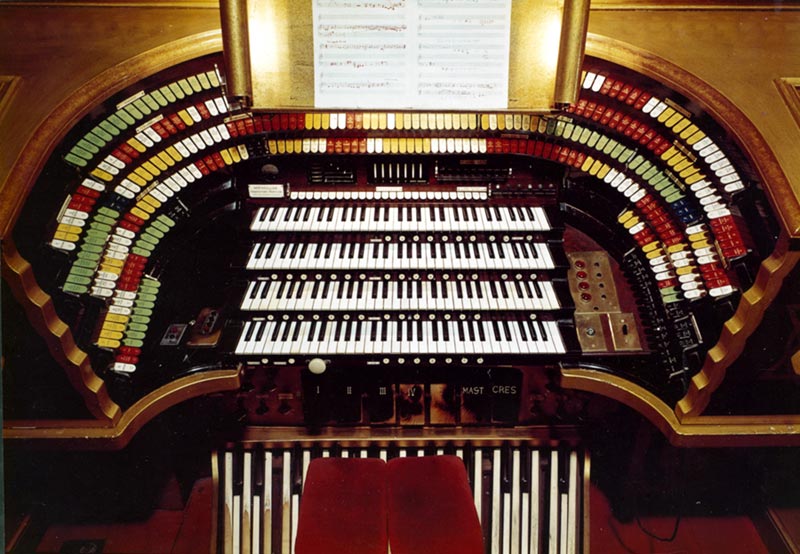
| Rank | Pitch | # of Pipes | Wind | Description |
| Chamber A | ||||
| Chimney Flute | 8'-2' | 85 | 15" | |
| Solo Violins III | 8'-2' | 255 | 15" | One Rank Sharp |
| One Rank Neutral | ||||
| One Rank Sharper | ||||
| Clarinet | 16'-4' | 73 | 15" | T.C.Limit |
| Orchestra Oboe | 8'-4' | 73 | 15" | |
| Kimura | 8'-4' | 73 | 15" | |
| Minor Vox Humana | 16'-4' | 73 | 15" | T.C.Limit |
| 1st Snare Drum | Ludwig | |||
| 2nd Snare Drum | Ludwig | |||
| 1st Bass Drum | Standard Ludwig | |||
| 2nd Bass Drum | Standard Ludwig | |||
| Muffled Drums | Ludwig | |||
| Chinese Blocks (Two) | ||||
| Tom-Tom (Two) | ||||
| Castanets (Two Pair) | ||||
| Tambourine (Two) | ||||
| Shuffle | ||||
| 1st Cymbal | Zildjian | |||
| 2nd Cymbal | Zildjian | |||
| Persian Cymbal | Zildjian | |||
| Chinese Gong (Two) | ||||
| Song Birds | ||||
| Song Birds II | ||||
| Song Birds III | ||||
| Siren I | ||||
| Siren II | ||||
| Ford (Automobile) Horn | ||||
| Door Bell | ||||
| Auto Horn | ||||
| Steamboat Whistle | ||||
| Slap Sticks (Two) | ||||
| Triangle (Two) | ||||
| Sleigh Bells (Two) | ||||
| Wind Effect | ||||
| Ding Dong I | ||||
| Ding Dong II | ||||
| Locomotive Bell | ||||
| Locomotive Whistle | ||||
| Chamber B | ||||
| Diaphonic Diapason | 16'-8' | 109 | 15" | Bottom 12 Wood |
| Tibia Glausa | 16'-2' | 121 | 15" | |
| Viola | 16'-1-3/5' | 109 | 15" | |
| Gamba | 8'-4' | 85 | ||
| Gamba Celeste | 8'-4' | 85 | ||
| Solo Post Horn | 16'-4' | 109 | ||
| Post Horn | 8'-4' | 85 | ||
| French Trumpet | 8'-4' | 85 | ||
| Marimba | 8' | 49 Bars | ||
| Glockenspiel | 8' | 37 Bars | ||
| Chimes | 25 Tubes | Large Scale With Damper | ||
| Chamber C | ||||
| Stentorphone | 8' | 85 | 15" | |
| Tibia Plena | 16'-4' | 109 | 15" | |
| Bourdon | 16'-2' | 121 | 15" | |
| Violin Cello | 16'-2' | 109 | 15" | |
| Harmonic Tuba | 8'-4' | 109 | 15" | |
| Saxophone | 8'-4' | 73 | 15" | |
| Englosh Horn | 8'-4' | 73 | 15" | |
| Violin Cello Celeste | 8'-4' | 85 | 15" | |
| Harp | 61 Bars | With Dampers | ||
| Zylophone | 49 Bars | |||
| Chamber D | ||||
| Solo Tibia Clausa | 16'-2' | 97 | 15" | |
| Gemshorn | 8'-4' | 73 | 15" | |
| Gemshorn Celeste | 8'-4' | 73 | 15" | |
| Orchestral Violins (Three Ranks) | 8'-2' | 255 | 15" | One Rank Sharp |
| One Rank Neutral | ||||
| One Rank Sharper | ||||
| French Horn | 8'-4' | 85 | 15" | |
| Mezzo Vox Humana | 8'-4' | 73 | 15" | |
| Chrysoglott | 37 Bars | |||
| Chamber E | ||||
| Open Diapason | 8' | 73 | 6" | |
| Dulciana | 8' | 73 | 6" | |
| Stopped Diapason | 8' | 73 | 6" | |
| Flute Harmonic | 4' | 73 | 6" | |
| Salicional | 8' | 73 | 6" | |
| Vox Celeste | 8' | 61 | 6" | |
| Small Trumpet | 8' | 73 | 6" | |
| Oboe | 8' | 73 | 6" | |
| Vox Humana | 8' | 61 | 6" | |
| Bourdon | 16' | 44 | 6" | |
| House Right and Left Not Under Expression | ||||
| Diaphonic Diapason | 32' | 12 | 25" | |
| Center Orchestra Pit - Baldwin 6' Grand Piano | 88 Keys |
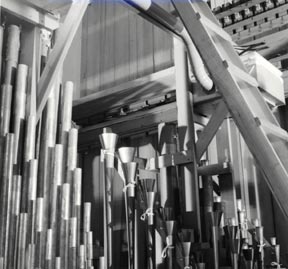

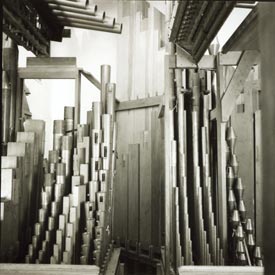
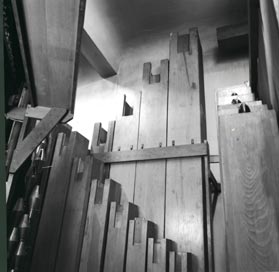
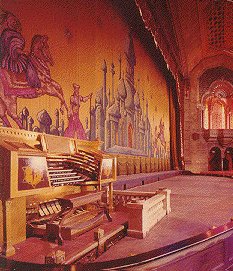 The wind required
for the organ is supplied by a blower which is powered by a
75-horsepower
motor. This electro-pneumatically operated instrument is so vast
and complex that it has real instruments in it such as a marimba,
xylophone and glockenspiel. The Theatre's grand piano can be remotely
played from the organ's keyboard. The organ uses a complex system
of translating the actions of its organist to the wonder music
it makes. Each relay has a corresponding pneumatic for each manual
and pedal note on the console. When a key or tab stop is pulled
on the console, a circuit is closed. The corresponding relay pneumatic
is deflated, thereby actuating a contact bar. As the various stops
are drawn at the console, a large switch pneumatic inflates in
the relay, causing a series of contact strips to shift position
and come in contact with the actuated contact bar. This in turns
causes air to be sent to the appropriate pipe or mechanical action
called for to make the desired sound.
The wind required
for the organ is supplied by a blower which is powered by a
75-horsepower
motor. This electro-pneumatically operated instrument is so vast
and complex that it has real instruments in it such as a marimba,
xylophone and glockenspiel. The Theatre's grand piano can be remotely
played from the organ's keyboard. The organ uses a complex system
of translating the actions of its organist to the wonder music
it makes. Each relay has a corresponding pneumatic for each manual
and pedal note on the console. When a key or tab stop is pulled
on the console, a circuit is closed. The corresponding relay pneumatic
is deflated, thereby actuating a contact bar. As the various stops
are drawn at the console, a large switch pneumatic inflates in
the relay, causing a series of contact strips to shift position
and come in contact with the actuated contact bar. This in turns
causes air to be sent to the appropriate pipe or mechanical action
called for to make the desired sound.
The organ, just like the Fox, enjoyed good times and suffered
through other periods, which might be described as "lean
years." Since the Fox operated without making any form of
substantial profit, repairs and maintenance were pretty much done
on an "as needed" basis and most of the time, the Organ
did not fall into that category. When Noble Arnold became the
Fox's General Manager in 1951, one of his first official acts
was to have the Fox Möller repaired so it could be played.
The repairs were done in a patchwork method and problems continued
to haunt the organ. By 1954 it had become increasingly taxing
upon the organist's resources to get through a music selection
without a series of awkward silent periods, that the organ fell
silent for almost 9 years.
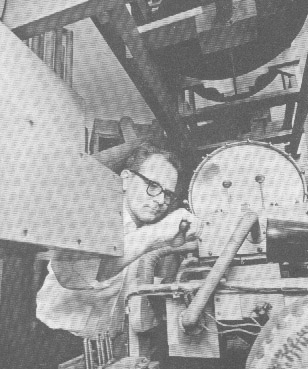 In December, 1962,
American Theatre Organ Society President "Tiny" James
and Regional Vice President Erwin Young made arrangements to interview
Noble Arnold, city manager of the theatre chain, for the purpose
of determining what his plans were for the organ and to offer
the assistance of the Southeastern Chapter. Mr. Arnold had for
many years shown an enthusiastic interest in the theatre organ.
His wife, a very prominent musician and theatre organist, had
studied with the late Jesse Crawford and on numerous occasions
had substituted for Crawford. Mr. Arnold agreed to allow an inspection
of the instrument by a ATOS committee of the Southeastern Chapter.
Early in 1963, under the direction of Southeastern Chapter's Chairman
Carl Norvell and Vice Chairman Bob Van Camp, a committee of four
was appointed to make a thorough inspection of the organ.
In December, 1962,
American Theatre Organ Society President "Tiny" James
and Regional Vice President Erwin Young made arrangements to interview
Noble Arnold, city manager of the theatre chain, for the purpose
of determining what his plans were for the organ and to offer
the assistance of the Southeastern Chapter. Mr. Arnold had for
many years shown an enthusiastic interest in the theatre organ.
His wife, a very prominent musician and theatre organist, had
studied with the late Jesse Crawford and on numerous occasions
had substituted for Crawford. Mr. Arnold agreed to allow an inspection
of the instrument by a ATOS committee of the Southeastern Chapter.
Early in 1963, under the direction of Southeastern Chapter's Chairman
Carl Norvell and Vice Chairman Bob Van Camp, a committee of four
was appointed to make a thorough inspection of the organ.
As the inspection reported that the organ was in relatively good condition. The major area of trouble was confined to the cable connecting the console with a junction board in the pit. After years of being coiled, uncoiled, dragged across concrete, saturated with grease, pulled and stretched, the cable was in sad shape. Of a total of 63 dead manual circuits at the console, only two were found to be dead from the relays. There were a few slightly damaged pipes, several broken reeds, and a number of percussions needing minor repairs, one or two ciphers, miscellaneous minor wind leaks, and inoperative tremolos. Chamber "C" contained a reservoir that required re-leathering that had been previously "repaired" with oilcloth and friction tape. A "new" curtain valve had been improvised with the help of a few materials heretofore generally unknown to the organ industry: a piece of oilcloth, a broken yardstick, oversized carpet tacks, a piece of coat hanger, and a shoe lace.
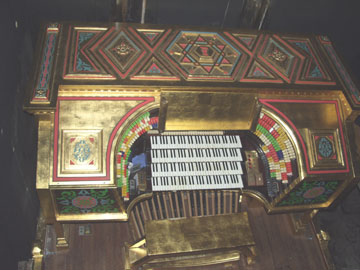 The
blower room revealed dry bearings, which were already approaching
a critical stage of heat. They were lubricated immediately, The
generator, while rated at eleven volts, produced only ten volts
at the console at idle and dropped to six volts when full organ
was played. Direct current terminals throughout were checked and
found to be loose and dirty. All rubber tubing in the console
had ossified and required replacement. Some ivories (keys or pulls)
were missing from the manuals, key contacts were dirty, indicator
lights were burned out, combination action needed adjusting, and
the hinged junction boards at the rear of the console were just
hanging and could more properly be described as an electrician's
nightmare.
The
blower room revealed dry bearings, which were already approaching
a critical stage of heat. They were lubricated immediately, The
generator, while rated at eleven volts, produced only ten volts
at the console at idle and dropped to six volts when full organ
was played. Direct current terminals throughout were checked and
found to be loose and dirty. All rubber tubing in the console
had ossified and required replacement. Some ivories (keys or pulls)
were missing from the manuals, key contacts were dirty, indicator
lights were burned out, combination action needed adjusting, and
the hinged junction boards at the rear of the console were just
hanging and could more properly be described as an electrician's
nightmare.
Once the inspection was complete, Mr. Arnold reviewed and approved a proposal from the Chapter to restore the instrument in exchange for its occasional use. Joe Patten of College Park, Georgia, an electrical engineer for Westinghouse Electric Corp., was selected to head the work crew. His first step to restoring the instrument was to perform an extensive cleaning of all the areas and rooms the organ utilized prior to undertaking any repair work. Workers were dumbfounded as to the amount of dirt and debris that had collected in the 33 years since the organ was new. It was equally amazing to see how spacious the chambers actually were once the clean up was completed. With that portion of the restoration complete, the actual restoration could commence. The generator was removed and completely rebuilt. Some 36,000 feet of stranded cable, to withstand the coiling and uncoiling, was connected from the console to a new junction board in the pit. A cable tray was built which would contain the coiled cable, keeping it from being ground away on the concrete floor as the original had. One by one the various repairs were made. Mr. Arnold's staff painters then began applying coat after coat of gilt to the console, touching up broken pieces of ornamentation, recovering swell pedals. The Howard seat was not overlooked. It was given a new suit of red velvet edged in gold beading.
The organ was to have it public debut after its restoration on November 23rd, 1963, but the performance was cancelled when an assassin's bullet murdered President John Kennedy in Dallas that day. The concert was rescheduled and on Thanksgiving Day, November 28, 1963, at 3:30 p.m., the giant Möller console again ascended from its resting place for its first public appearance in almost ten years. Organist Bob Van Camp, now with the title of Fox House Organist, joyously performed Georgia On My Mind, followed by Days of Wine and Roses, Alley Cat, and Valencia. Bob Van Camp remained the Fox Theatre's house organist for the remainder of his life. He died in the late 1980s.
In the mid-eighties, The Möller organ went through another period of restoration. This time is wasn't only a restoration but a true completion. The paperwork from the Möller Organ Company regarding the organ showed that there were several sets of pipes that were not installed. Because the Fox Theatre was not quite completed before the start of the Great Depression, many businesses that were involved in supplying materials for the Atlanta Fox ceased business. Pipes matching the description called for in the original blueprints were sourced and installed in the pipe chambers. Upon inspection of the rest of the organ, it was determined the Möller was in excellent condition. As testament to the ATOS members that loving repaired the organ in 1963, only one wire out of the thousands put in place during that restoration had broken.
With the Fox now being under a very stable management and secure financially, the organ gets the regular attention it needs by Joe Patten and other members of the ATOS. Now going into its 75th year, Mighty Mo is incredibly better than it was when new and has a wonderful future ahead of it.
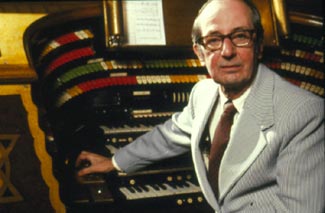 Bob
Van Camp
Bob
Van CampI met Bob Van Camp in the early days of the Save the Fox movement. He was quiet, modest man and full of life, especially when it came to theater organs! Bob worked for WSB Radio as an announcer. In his heyday, he was the voice of that radio station and when you heard it, it was instantly recognizable. Until he started performing at the Fox in 1963, few people in the city knew he was a renowned pipe organist. In addition to his duties at WSB and the Fox, Bob was the Master of Ceremonies of the Atlanta Pops Concerts in the 60s and 70s.
Once the Mighty Fox Möller Organ was restored to full
working order in November of 1963, Bob became the Fox Theatre's
official House Organist. Bob Van Camp was the house organist for
more than 25 years. When he died, Patten and Atlanta Landmarks
board member Robert L. Foreman Jr. sprinkled his ashes in the
attic over the
organ chambers.
In 1968, with Bob Van Camp at the Mighty Mo and Joe Patten behind the controls of an audio tape recorder, together they made a set of recordings that produced two records of Bob and Mo, one of them was called "Here With The Wind". I still have my copy! In 1997, Joe Patten took the original recordings and had them digitally mastered for a two-disc Compact Disc album; "The Atlanta Fox Theatre Remembers Bob Van Camp at its Mighty Möller Organ". The CD is now out of print, but as of early December 2004, the Fox still had a few copies available for sale.
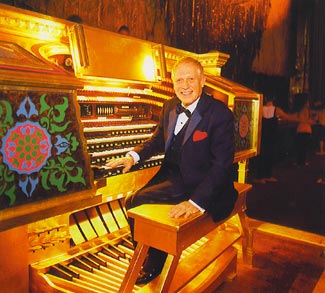 Larry
Douglas Embury
Larry
Douglas EmburyIn the summer of 2002, Larry Douglas Embury was invited to become Organist in Residence at Atlanta's Fox Theatre, filling the position that had been vacant since Bob Van Camp's death in the late 1980s. Larry has combined his natural talent for improvising with formal classical studies. He graduated from King's College Academy and studied piano with the Canadian concert pianist Glen Geary. He went on to study organ with Dr. Raymond Cluderay of St. Andrew's Wesley Cathedral of the United Presbyterian Church, and with Dr. L. Allyne Swann at Northwest Nazarene University in Nampa, Idaho; for two years, he studied with Richard Purvis, the noted composer and organist of San Francisco's Grace Cathedral.
Ed Neiss, General Manager of the Fox, said: "Larry has brought new life back into the Mighty Möller organ at the Fox. His command of the instrument coupled with his unique playing style meshes greatly with the friendly rapport he has with the audience." Beauchamp C. Carr, Vice President of Atlanta Landmarks, which operates the Fox (and Executive Vice President of Atlanta's Woodruff Arts Center), "The Möller organ is the Fox's soul, and we're thrilled to have Larry playing it brilliantly for a new generation of Atlantans." Joe G. Patten remarked, "The first time Larry played the Fox organ I felt he was comfortable with it, and I with him. It is a unique instrument, and it requires a sensitive artist to get the most out of it. I realized that Larry could provide us an opportunity to present his superb artistry in the service of the Fox Theatre so this is a culmination of my hopes for the instrument."
Embury, now makes his home in Atlanta, Georgia just a few blocks away from the Fox Theatre.
I have seen three versions of the name of the company that manufacturered Mighty Mo. Using phonetics, it is pronounced Moeller (Moe-ler) and the majority of literature and organ afficianados use this spelling. But others do use "Moller" or "Möller" and if you look on the console of Mighty Mo, the manufacturer's nameplate states the instrument was manufactured by the "M.P.Möller Company". Therefore, I am using the spelling on the instrument. I assume this comes from two different reasons. The first is that it was somewhat traditional for Europeans to alter their names to suit the American tongue. A good example of this was the Famous Chef Boyardee changing the spelling of his name so that it would be pronounced right. Moeller, would be the phonetically correct spelling of Möller.
The other, most simple and logical reason is that a lot of people using American typewriters didn't have the correct key to type a "O" with two dots above it when it wrote the name. This would explain Moller for other instances.
Webmaster's notes: the material presented in this page describing its major 1963 restoration was compiled and edited from an article written by Arli W. Southerland of the American Theatre Organ Society for one of its newsletters in 1963 or 1964 about the ATOS's restoration of the Fox's organ.